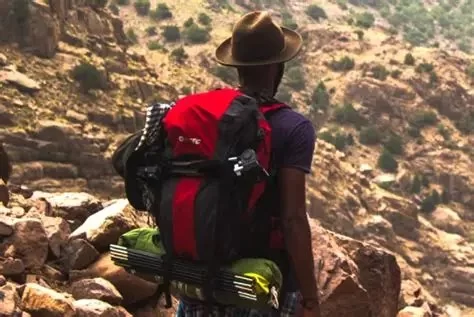- desert-backpacking-climate-considerations - Understanding the Harsh Desert Climate and Its Challenges
- hydration-systems-and-water-management - Essential Hydration Gear and Water Strategies
- desert-clothing-and-protection - Choosing the Right Clothing for Desert Protection
- navigation-and-safety-equipment - Navigation Tools and Emergency Gear You Should Carry
- sleeping-gear-and-shelter - Staying Cool and Protected: Sleep Systems and Shelter
- personal-story-from-mojave - Real Story: Lessons from a 3-Day Solo Trek in the Mojave
- recommended-resources - Where to Find the Right Gear and Advice
1. Understanding the Harsh Desert Climate and Its Challenges
Before packing a single item, it’s essential to understand what makes desert backpacking uniquely demanding. The extreme temperature swings—from scorching heat during the day to chilling cold at night—can be physically and mentally taxing. Add in unpredictable sandstorms, relentless sun, and minimal water sources, and you’ve got a test of endurance even for seasoned hikers.
Planning for these extremes isn’t optional—it’s the foundation of your safety. Understanding how your body reacts to heat, how quickly you dehydrate, and how much rest you’ll need is crucial for selecting the right gear and route.
2. Essential Hydration Gear and Water Strategies
2.1 Water Carriers and Filtration Tools
Carrying enough water in the desert is a matter of survival. Experts recommend at least one gallon (about 4 liters) per person per day. Rigid bottles, hydration bladders, and collapsible containers each serve different purposes. It’s smart to combine all three. Don’t forget a reliable water filtration or purification system—you may not find water often, but when you do, it likely needs treatment.
2.2 Stashing and Rationing
Experienced desert backpackers sometimes cache water along their route in advance, especially for long treks like the Arizona Trail. Apps like Gaia GPS or printed topographic maps help mark these stash points accurately. And always ration wisely—never drink all your water at once, but also never hold off so long you risk heat exhaustion.
3. Choosing the Right Clothing for Desert Protection
3.1 Layering for Temperature Swings
Desert gear isn’t just about keeping cool—it’s about managing your body's climate. A wide-brim hat, UPF-rated long sleeves, and ventilated hiking pants are standard. In the cooler desert nights, a lightweight insulated jacket becomes your best friend. Avoid dark colors; they absorb too much heat.
3.2 Footwear and Sand Protection
Footwear needs to offer breathability and ruggedness. Trail runners are often preferred over boots due to their lighter build. Don’t underestimate the usefulness of gaiters—they keep fine sand and pebbles from turning your hike into a painful slog.
4. Navigation Tools and Emergency Gear You Should Carry
4.1 GPS and Traditional Navigation
Never rely solely on your phone’s GPS in the desert. Batteries die quickly in extreme heat. A dedicated GPS device with offline maps is more dependable. Pair it with a physical map and compass for backup. The best adventurers plan as if they'll get lost—even if they never do.
4.2 Emergency Essentials
A lightweight but well-stocked first aid kit, signal mirror, whistle, emergency bivvy, and satellite communicator (like Garmin InReach) can save your life. One hiker, lost in Utah’s Escalante desert, was rescued only because he activated his satellite SOS after getting stranded with no cell service.
5. Staying Cool and Protected: Sleep Systems and Shelter
5.1 Ultralight Desert Shelters
Forget heavy tents—go with a lightweight tarp or mesh tent with a reflective rainfly. Ventilation is key. Many backpackers even cowboy camp (sleeping under the stars), but insect nets and a good groundsheet are still advisable.
5.2 Sleeping Pads and Bags
A foam or insulated inflatable pad keeps you off the cold desert floor. As for sleeping bags, a 40°F-rated bag or even just a quilt may suffice for summer desert nights. Make sure it’s compressible, breathable, and not overkill—space and weight matter.
6. Real Story: Lessons from a 3-Day Solo Trek in the Mojave
Last spring, I ventured into the Mojave Desert alone—three days, 38 miles, zero cell signal. I underestimated the dry wind and didn’t reapply sunscreen after sweating. Result? Sunburned shoulders and mild dehydration on day two. What saved me was a gravity water filter I used on a muddy seep, and a reflective tarp that kept me from overheating in the mid-day sun.
That trip taught me this: gear isn't about looking like a pro—it’s about surviving like one. I now double-check my headlamp batteries, always bring electrolyte powder, and plan breaks around shade spots, not mileage.
7. Where to Find the Right Gear and Advice
Choosing the right gear for desert backpacking takes research and trusted recommendations. For curated gear lists, tried-and-tested backpacks, hydration systems, and sun-protective clothing, check out Pine Cliff Resort. They not only stock top-tier equipment but also offer local advice, guided desert excursions, and workshops for beginners. Whether you're planning a weekend trip to Joshua Tree or a full thru-hike in the Sonoran region, having the right support can make all the difference.
Your next desert adventure can be thrilling, humbling, and unforgettable—just make sure you’re prepared with the gear that actually works in real desert conditions.







